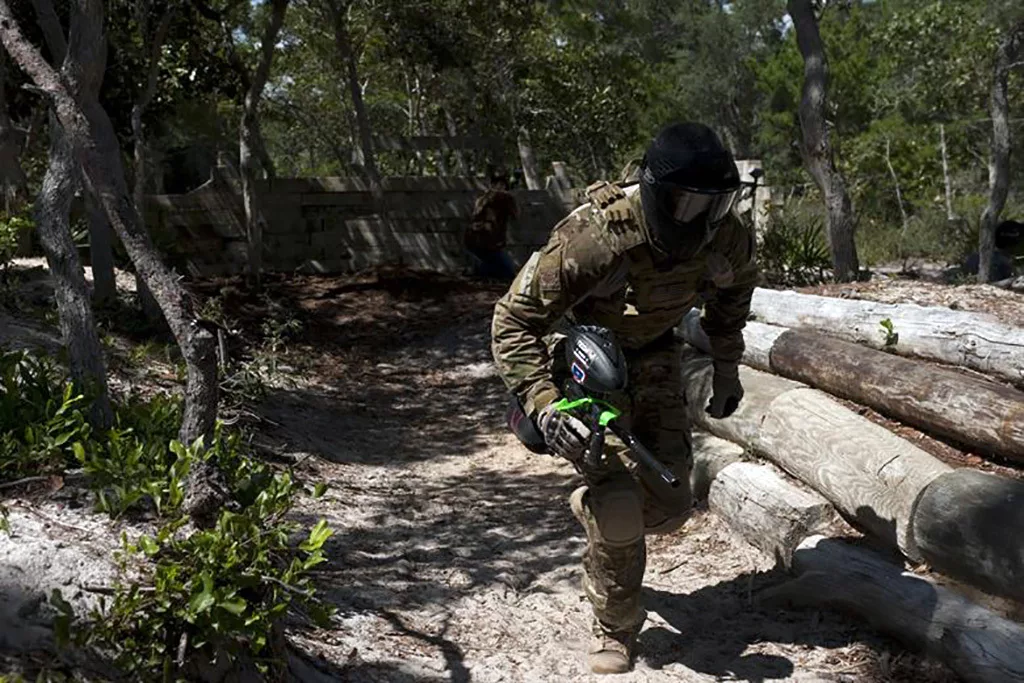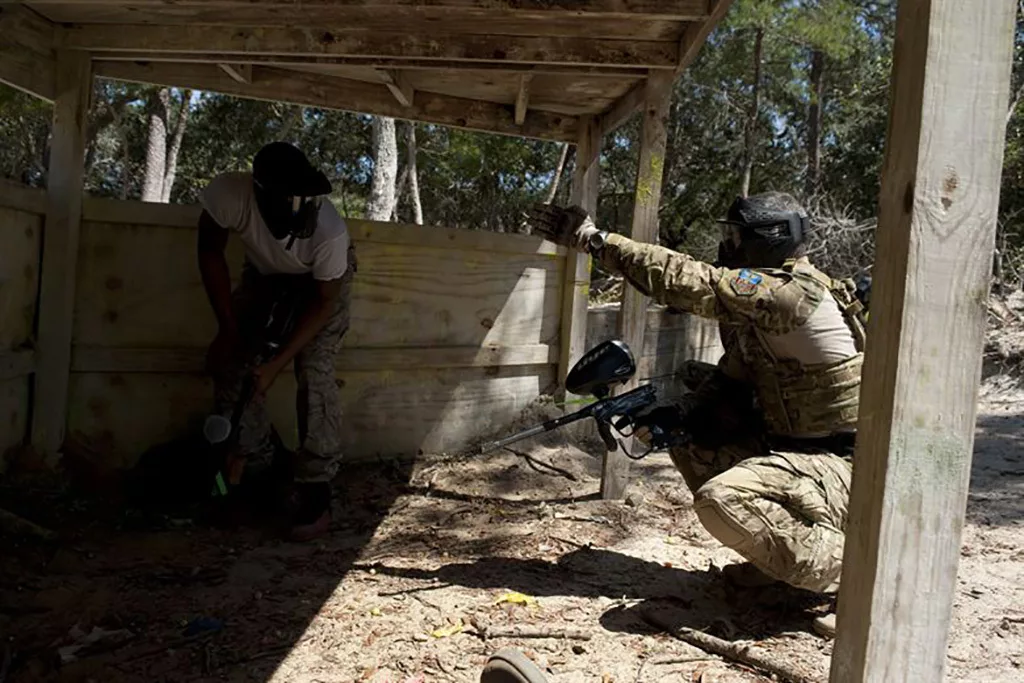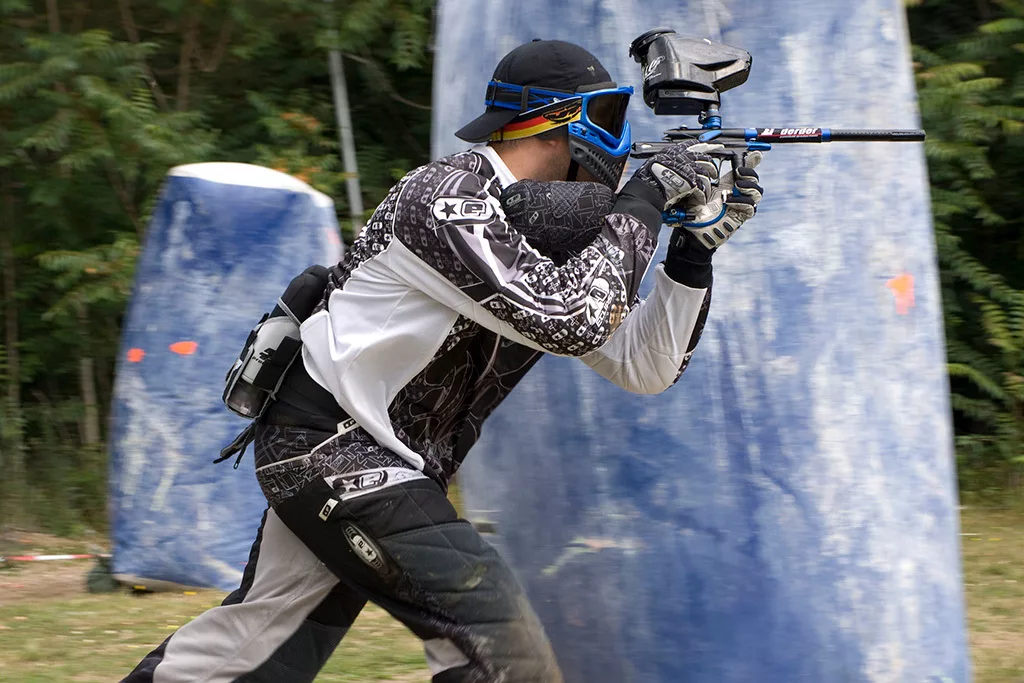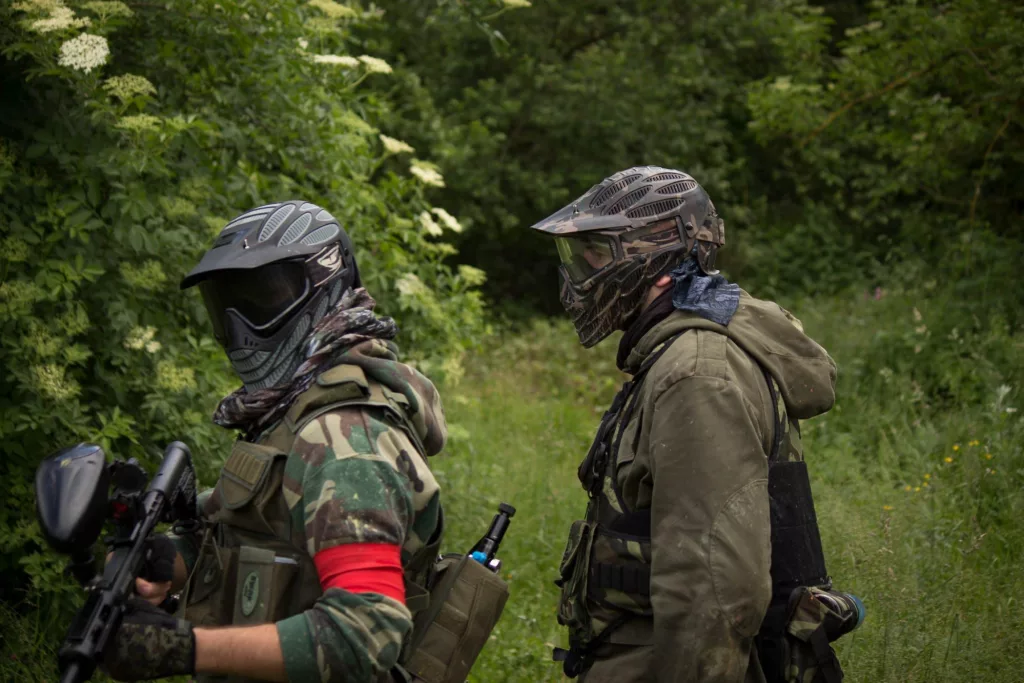Improve Your Game Today (Beginner & Advanced)
Paintball is an exhilarating game of strategy. Whether you’re a first-timer or advanced, our guide with 26 paintball strategy and tactic tips has you covered.
You Googled something related to “paintball strategy” and ended up here.
Lucky you.
Paintball is an exhilarating, fast-paced game of strategy. It’s a lot like chess, except there are about 10 times as many people running around with complex individual and group-based strategic elements mixed in with the larger team objective.
(OK, so I guess paintball is only a little like chess.)
No matter your skill level or experience, this guide has something for you.
I’ve broken it down into two major sections.
- Beginner strategies
- Advanced strategies
If you’re a first-timer, you can think of this guide almost like step-by-step instructions to go from novice to experienced, starting from the top.
Let’s get started.
20 Beginner Paintball Tips & Strategies
Paintball is easy to understand but difficult to master. In this beginner-level section, we’ll cover three things you should know before hitting the battlefield:
- Positioning and movement
- General rules of teamwork
- Beginner paintball strategies

10 Tips For Optimal Positioning & Movement
The way you move around the field and position yourself around objects is the most basic paintball skill to learn. It’s the foundation for everything else on this list. When it comes to positioning and movement, there are three things to keep in mind:
- Be fluid
- Be deceptive
- Be ready
Here are 10 pointers to help you achieve all three.
1. Stay low
A tall target is easier to spot (and easier to hit).
2. Keep your eyes level
Avoid moving with your head bobbing up and down, especially across uneven terrain. Instead, let your lower body adjust to any small changes in topography so that your head can remain at the same level as you move down the field. This will do wonders for your accuracy should you need to fire on the run and helps you lock onto a target faster once you reach your next spot on the field.
3. Keep your eyes up
Always move with your eyes up looking down the field. This makes it easier to react to anything that suddenly presents itself as a threat.
4. But watch where you step
But at the same time, make sure you don’t trip over anything. Not only could you get hurt, but it’s an easy way to give away your position! Survey the terrain you’re about to traverse before moving across it, and learn to feel your way around the field with your feet and lower body.
If you’re a woodsball player, a lightweight pair of tactical boots can do wonders for both your footing and ankle support.
5. Move with your marker up
Sticking with the theme of “always be ready to fire,” you should always keep your marker in position. If you’re moving fluidly with a level head, eyes up, and marker up, you’ll be in position to react to anyone who fires upon you (or successfully eliminate any targets that present themselves as you’re moving).
6. Be patient
Don’t try to move all the way across the field in record time (unless it’s part of your larger team strategy). Stealth is all about patience.
7. But be decisive
But don’t be so patient that it borders on indecision. Sometimes windows to move are open for just a few seconds, and you need to capitalize before they close! Finding the proper balance between patience and aggressiveness can take time to master, but it’ll become easier as you build confidence in your skills.
8. Make a mental field map
You don’t want to be caught in a corner without knowing how to get out. That’s why it’s important to be aware of your surroundings at all times while mentally recording how your field is laid out.
- Where are the dips?
- Where are the natural obstacles?
- Where are good places for cover?
- What are the best escape routes from various places on the field?
- How long does it take to move from point to point?
The faster you commit the field’s layout to memory, the less you’ll need to think in each moment, which helps you be more decisive on the battlefield.
9. Never shoot over obstacles
It’s rarely a good idea to look over obstacles. When you look over the top, you need to expose the whole top of your head to see what’s happening. And if you see something worth firing at, you need to either bring your upper body over the top as well or relocate to the side of the obstacle for a less exposed shot.
10. Position yourself to shoot around obstacles
Instead, it’s better to just position yourself to look around the side from the get-go. Handedness is important here, too. Right-handed shooters will find it easier to cover the rest of the field in paint when positioned on the left side of the field. This allows you to poke your gun around the right side of obstacles while still having great visibility from a shielded position.

5 General Rules of Teamwork
Most paintball game variations require some degree of teamwork. Before we get into beginner (and intermediate) strategies below, let’s talk about the general rules of teamwork.
1. Play to everyone’s strengths
You don’t see 250-pound NFL defensive backs covering speedy wide receivers. It just isn’t the best use of their skills. Similarly, in paintball, players can have all types of strengths. Some players are fast, agile, and stealthy. They make great front-line players pushing your team up field. Others are great at long-distance accuracy and are better-suited to sniping. If you don’t know everyone on your team, just ask them what they’re good at. Play a game or two and then reassess.
2. Have a plan
Every type of paintball game has an objective. Your team should have a plan for how to achieve that objective so everyone knows what’s expected of them and what other players will be doing.
3. Have a backup plan
Mike Tyson famously said, “Everyone as a plan until they get punched in the face.” Paintball is a fast-paced and often unpredictable game, and sometimes you need to go to Plan B or Plan C.
4. Communicate
Communication is key, and it takes two forms: pre-game and in-game communication. Before the game, make sure everyone understands the plan, the backup plan, and their role. During the game, use hand signals or other gestures to communicate movements in the least conspicuous ways possible.
5. Put the team first
Team-based paintball games are team victories. No one likes to get eliminated, but sometimes you need to elevate your team above yourself for the greater good. Several of the paintball strategies discussed below require players put themselves at risk for the benefit of the team.

5 Beginner Paintball Strategies
Here are a few beginner and intermediate paintball strategies and tactics your team can use to take down the competition.
If you’re truly a beginner, there are a few other guides on Paintballer you should check out:
- How To Play Paintball
- How Much Does Paintball Cost? 35 Potential Expenses
- Does Paintball Hurt?
- 21 Paintball Rules For A Fun, Pulse-Pounding Day On The Field
- Top 10 Best Paintball Guns
1. Move up the field
Not a tactic per se, but your team should always be trying to take field away from your opponents (with a few notable exceptions). When your opponents get backed up, you force them into a more concentrated area. This makes it easier to get eliminations and more challenging for your opponents to put a plan into action.
Remember the “have a plan” and “have a backup plan” tips above? I guarantee your opponents’ primary plan isn’t to get overwhelmed in their own zone. Moving forward pushes them to their backup plan (if they have one).
2. Militia Line
One team play tactic to push your opponents back is something I like to call the Militia Line. Picture a Revolutionary War battle between British Redcoats and American militiamen with both sides standing in wide rows firing shots downfield at the opposition.
We laugh at the tactic today (why would you just stand there and take fire?) but there’s some value in it on the paintball field. Except instead of standing in the open, your team is spread out across the field behind obstacles with no more than two people behind any one barricade. This spread out approach makes it challenging for the opposing team to pin you down, and you can rain fire on them from all angles while slowly advancing up the field.
The downside of the Militia Line tactic is your team can easily be fractured if the plan fails, which is yet another reason to have an effective Plan B.
3. Flanking
The easiest way to eliminate your opponents is to sneak up on them from the sides and back. With Flanking, a few of your teammates serve as distractions to draw opposing players up the middle of the field while the rest of you move around the sides for better firing angles. This pins your opponents in crossfire and allows you to close in on them. You may lose the players used as bait, but team-based paintball is about the glory of the team, not the individual.
4. Leapfrogging
This tactic, borrowed in name from the childhood game and in practice from actual military tactics, allows two or more players to move across the field with decreased risk of being eliminated. In leapfrogging, the rear-most player pushes forward while the other player(s) serve as lookouts and provide cover fire as needed.
5. Cover Fire Rushing
One of paintball’s most aggressive tactics, Cover Fire Rushing is when your entire team rushes upfield while one or two players provide cover fire. It’s a near-guaranteed way to get several players on your own team eliminated, but it puts immense strain on your opponent. Cover Fire Rushing works best from a position of numeric strength when you can afford the losses in order to overwhelm an already decimated opponent.

6 Advanced Paintball Strategies & Tactics
If you’ve mastered beginner paintball strategy, especially the section on positioning and movement, you can start upping your game with these advanced individual and team tactics.
1. Zig Zag
The shortest distance between two points is a straight line, but straight lines in paintball often result in early eliminations. Moving targets are hard to hit, and unpredictable moving targets are even harder. What makes this an advanced tactic is that you aren’t just zig-zagging out of control. Your movements are fully controlled and you’re moving swiftly and purposefully with your marker up in firing position.
2. Now You See Me, Now You Don’t
In the section above with 10 beginner tips for positioning and movement, I said you should be stealthy and patient but also decisive. This tactic takes advantage of all three. If you’re pinned down by an opponent firing on you, wait until he or she takes cover behind an obstacle to reload or avoid fire. When that happens, stealthily move into a nearby bunker.
Remember, you’ve already made a mental map of the field!
When your opponent pops back out, they have no clue where you are. You have the upper hand. This seems like a simple tactic, but I promise you it takes time to master and is the result of making those 10 beginner tips seem like second nature.
3. Watch the Marshal
Have you ever pulled your car up to a blind intersection with trucks, walls, or bushes blocking your view of intersecting traffic? Most of these blind intersections have a rounded mirror mounted up high so you can see what’s happening from a safe place.
Now, pretend the Marshal’s eyes are that mirror. The Marshal’s job is to monitor play for eliminations and violations, and that means they’ll be watching the action. If you can see the Marshal from your hiding place, see what their eyes are doing.
- Where are they looking?
- Are they surveying the entire field or locked on one spot?
- Are they watching loosely or intently?
All of this is useful information as you plan your next move.
4. Own Your Right
Around 90% of the world’s population is right-handed. That means they probably fire right-handed and prefer to shoot around the right side of obstacles. Your team can take advantage of this by owning the right side of the field (your right side, opponent’s left as they come toward you).
This forces your opponent to play up their right side of the field, which means they have to shoot from the left side of obstacles in order to fire upon most of the field. This puts them at a significant disadvantage as they have to expose more of their bodies to get shots off or shoot with their left hand and compromise accuracy.
5. Dead Man Walking
An old tactic that many players frown upon and doesn’t work that often anyway, Dead Man Walking is when a player walks off the field like they’ve been eliminated when in reality they’re trying to deceive the other team to move to a new spot on the field.
6. Fake Retreat
Earlier I said, “your team should always be trying to take field away from your opponents (with a few notable exceptions).” This is one of those notable exceptions.
With the Fake Retreat, members of your team fall back into your own territory with your opponent bearing down on them. The other team thinks they’re gaining ground, but what they’re really doing is falling into your trap. Unbeknownst to your opponents, the remaining members of your team now have them flanked on both sides, ready to unleash the fury of a thousand paintballs (or whatever’s left in your hopper).
Paintball Strategy & Tactics: Final Thoughts
Paintball is a fast-paced game with individual, group, and team-based strategies all unfolding at once.
If you’re new to paintball, start by mastering these 10 beginner paintball tips:
- Stay low
- Keep your eyes level
- Keep your eyes up
- But watch your step
- Move with your marker up
- Be patient
- But be decisive
- Make a mental field map
- Never shoot over obstacles
- Position yourself to shoot around obstacles
It’ll take you at least a few games to feel comfortable and fluid on the field, but over time you’ll be able to move effectively without thinking about it, which opens you up to all kinds of individual and team strategies and tactics:
- Militia Line
- Flanking
- Leapfrogging
- Cover Fire Rushing
- Zig Zag
- Now You See Me, Now You Don’t
- Watch the Marshal
- Own Your Right
- Dead Man Walking
- Fake Retreat
Regardless of your skill level or the tactics you employ, just remember to be loose and have fun out there!
Credits
- Featured image courtesy Wallpaper Flare
- Movement and general rules of teamwork courtesy Hurlburt Field
- Cover Fire Rushing courtesy Flickr
- Advanced paintball strategy courtesy Pexels
